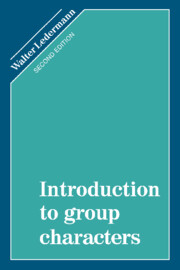Book contents
- Frontmatter
- Contents
- Preface to the second edition
- Preface
- 1 GROUP REPRESENTATIONS
- 2 ELEMENTARY PROPERTIES OF GROUP CHARACTERS
- 3 INDUCED CHARACTERS
- 4 PERMUTATION GROUPS
- 5 GROUP-THEORETICAL APPLICATIONS
- 6 ARITHMETIC PROPERTIES OF GROUP CHARACTERS
- 7 REAL REPRESENTATIONS
- APPENDIX
- List of character tables
- Solutions
- Bibliography
- Index
- Frontmatter
- Contents
- Preface to the second edition
- Preface
- 1 GROUP REPRESENTATIONS
- 2 ELEMENTARY PROPERTIES OF GROUP CHARACTERS
- 3 INDUCED CHARACTERS
- 4 PERMUTATION GROUPS
- 5 GROUP-THEORETICAL APPLICATIONS
- 6 ARITHMETIC PROPERTIES OF GROUP CHARACTERS
- 7 REAL REPRESENTATIONS
- APPENDIX
- List of character tables
- Solutions
- Bibliography
- Index
Summary
The aim of this book is to provide a straightforward introduction to the characters of a finite group over the complex field. The only prerequisites are a knowledge of the standard facts of Linear Algebra and a modest acquaintance with group theory, for which my text would amply suffice. Thus the present volume could be used for a lecture course at the third-year undergraduate or at the post-graduate level.
The computational aspect is stressed throughout. The character tables of most of the easily accessible groups are either constructed in the text or are included among the exercises, for which answers and solutions are appended.
It goes without saying that a book on group characters must begin with an account of representation theory. This is now usually done in the setting of module theory in preference to the older approach by matrices. I feel that both methods have their merits, and I have formulated the main results in the language of either medium.
In this book I confine myself to the situation where representations are equivalent if and only if they have the same character. As soon as this fundamental fact is established, the emphasis shifts from the representations to the characters. Admittedly, some information is thereby sacrificed, and I had to be content with somewhat weaker versions of the theorems of A. H. Clifford and G. W. Mackey.
- Type
- Chapter
- Information
- Introduction to Group Characters , pp. ix - xPublisher: Cambridge University PressPrint publication year: 1987



